College of Accountancy, Business, Economics: Communication Models
VerifiedAdded on 2021/11/23
|43
|8400
|91
Homework Assignment
AI Summary
This document, a set of notes from Batangas State University's Business Communication course, provides a comprehensive overview of communication models and directions in a business context. It begins by defining key terms like stimulus, filter, message, medium, and destination within the communication process. The notes then delve into formal and informal communication networks, detailing the four types of formal communication: downward, upward, horizontal, and cross-channel communication, along with their respective characteristics and examples. The document also discusses the informal communication network, or grapevine, highlighting its characteristics and significance in the flow of information within an organization. The notes emphasize the importance of understanding these concepts for effective business communication and organizational success, covering topics such as the importance of business communication, the communication process, and the different types of communication networks.
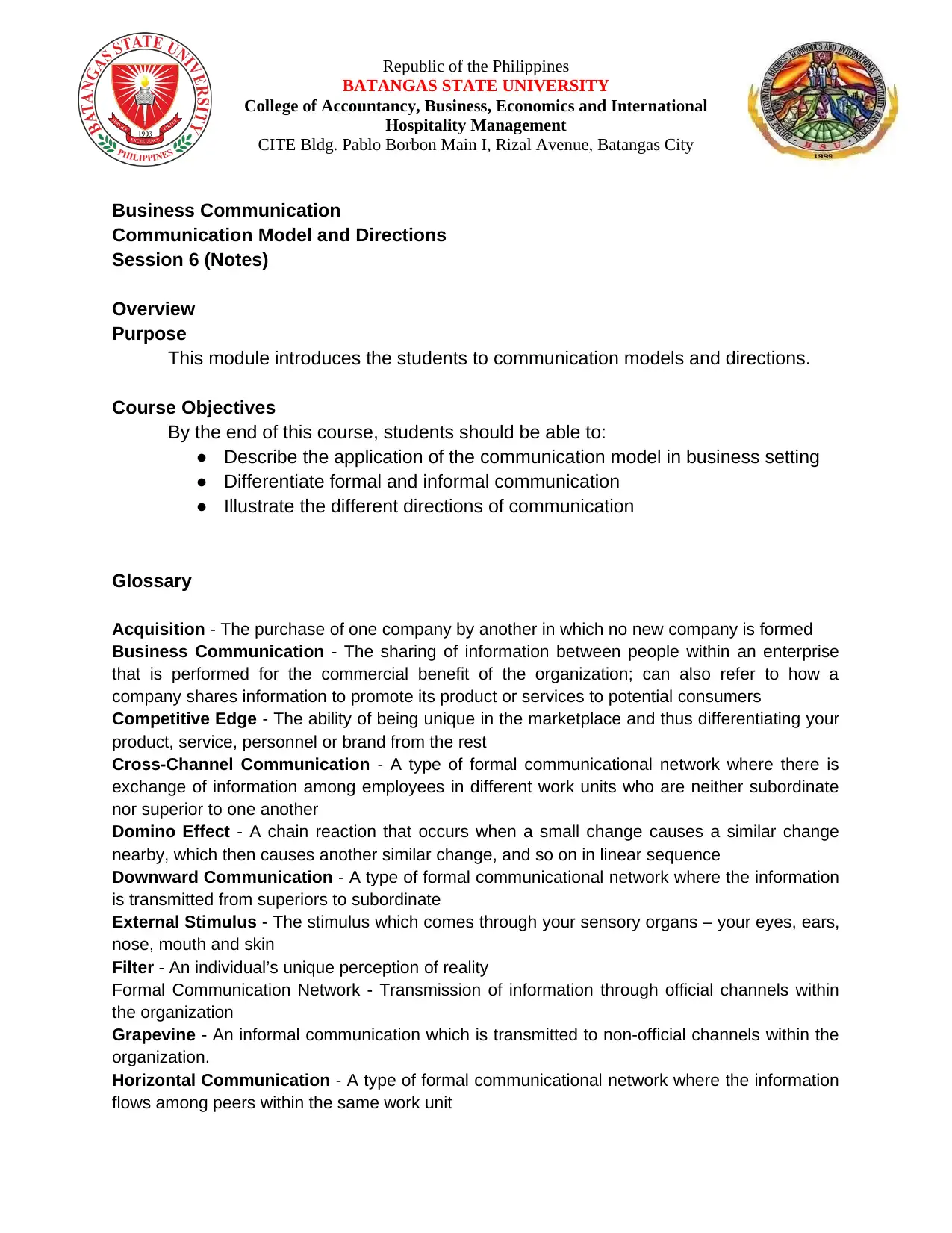
Republic of the Philippines
BATANGAS STATE UNIVERSITY
College of Accountancy, Business, Economics and International
Hospitality Management
CITE Bldg. Pablo Borbon Main I, Rizal Avenue, Batangas City
Business Communication
Communication Model and Directions
Session 6 (Notes)
Overview
Purpose
This module introduces the students to communication models and directions.
Course Objectives
By the end of this course, students should be able to:
● Describe the application of the communication model in business setting
● Differentiate formal and informal communication
● Illustrate the different directions of communication
Glossary
Acquisition - The purchase of one company by another in which no new company is formed
Business Communication - The sharing of information between people within an enterprise
that is performed for the commercial benefit of the organization; can also refer to how a
company shares information to promote its product or services to potential consumers
Competitive Edge - The ability of being unique in the marketplace and thus differentiating your
product, service, personnel or brand from the rest
Cross-Channel Communication - A type of formal communicational network where there is
exchange of information among employees in different work units who are neither subordinate
nor superior to one another
Domino Effect - A chain reaction that occurs when a small change causes a similar change
nearby, which then causes another similar change, and so on in linear sequence
Downward Communication - A type of formal communicational network where the information
is transmitted from superiors to subordinate
External Stimulus - The stimulus which comes through your sensory organs – your eyes, ears,
nose, mouth and skin
Filter - An individual’s unique perception of reality
Formal Communication Network - Transmission of information through official channels within
the organization
Grapevine - An informal communication which is transmitted to non-official channels within the
organization.
Horizontal Communication - A type of formal communicational network where the information
flows among peers within the same work unit
BATANGAS STATE UNIVERSITY
College of Accountancy, Business, Economics and International
Hospitality Management
CITE Bldg. Pablo Borbon Main I, Rizal Avenue, Batangas City
Business Communication
Communication Model and Directions
Session 6 (Notes)
Overview
Purpose
This module introduces the students to communication models and directions.
Course Objectives
By the end of this course, students should be able to:
● Describe the application of the communication model in business setting
● Differentiate formal and informal communication
● Illustrate the different directions of communication
Glossary
Acquisition - The purchase of one company by another in which no new company is formed
Business Communication - The sharing of information between people within an enterprise
that is performed for the commercial benefit of the organization; can also refer to how a
company shares information to promote its product or services to potential consumers
Competitive Edge - The ability of being unique in the marketplace and thus differentiating your
product, service, personnel or brand from the rest
Cross-Channel Communication - A type of formal communicational network where there is
exchange of information among employees in different work units who are neither subordinate
nor superior to one another
Domino Effect - A chain reaction that occurs when a small change causes a similar change
nearby, which then causes another similar change, and so on in linear sequence
Downward Communication - A type of formal communicational network where the information
is transmitted from superiors to subordinate
External Stimulus - The stimulus which comes through your sensory organs – your eyes, ears,
nose, mouth and skin
Filter - An individual’s unique perception of reality
Formal Communication Network - Transmission of information through official channels within
the organization
Grapevine - An informal communication which is transmitted to non-official channels within the
organization.
Horizontal Communication - A type of formal communicational network where the information
flows among peers within the same work unit
Paraphrase This Document
Need a fresh take? Get an instant paraphrase of this document with our AI Paraphraser
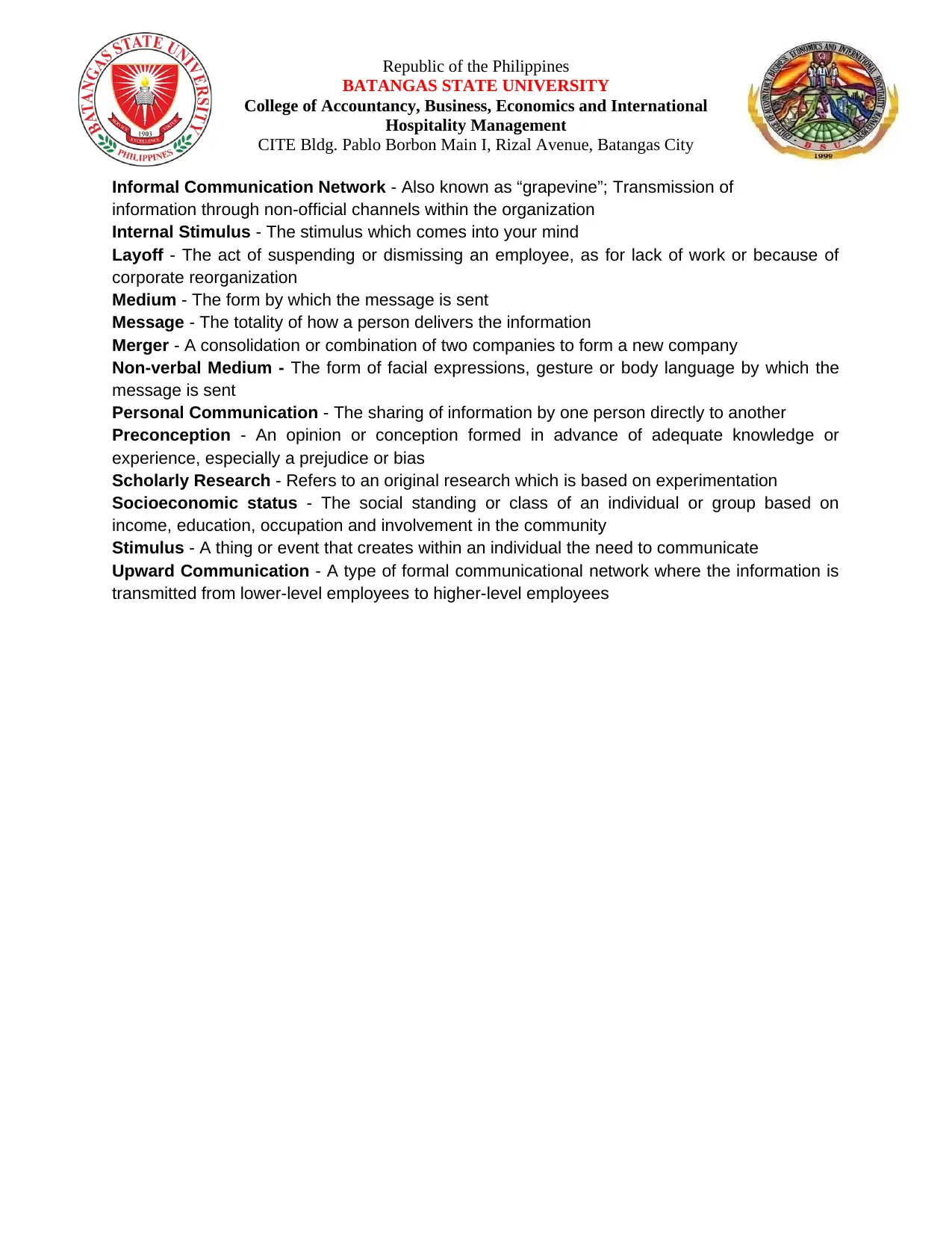
Republic of the Philippines
BATANGAS STATE UNIVERSITY
College of Accountancy, Business, Economics and International
Hospitality Management
CITE Bldg. Pablo Borbon Main I, Rizal Avenue, Batangas City
Informal Communication Network - Also known as “grapevine”; Transmission of
information through non-official channels within the organization
Internal Stimulus - The stimulus which comes into your mind
Layoff - The act of suspending or dismissing an employee, as for lack of work or because of
corporate reorganization
Medium - The form by which the message is sent
Message - The totality of how a person delivers the information
Merger - A consolidation or combination of two companies to form a new company
Non-verbal Medium - The form of facial expressions, gesture or body language by which the
message is sent
Personal Communication - The sharing of information by one person directly to another
Preconception - An opinion or conception formed in advance of adequate knowledge or
experience, especially a prejudice or bias
Scholarly Research - Refers to an original research which is based on experimentation
Socioeconomic status - The social standing or class of an individual or group based on
income, education, occupation and involvement in the community
Stimulus - A thing or event that creates within an individual the need to communicate
Upward Communication - A type of formal communicational network where the information is
transmitted from lower-level employees to higher-level employees
BATANGAS STATE UNIVERSITY
College of Accountancy, Business, Economics and International
Hospitality Management
CITE Bldg. Pablo Borbon Main I, Rizal Avenue, Batangas City
Informal Communication Network - Also known as “grapevine”; Transmission of
information through non-official channels within the organization
Internal Stimulus - The stimulus which comes into your mind
Layoff - The act of suspending or dismissing an employee, as for lack of work or because of
corporate reorganization
Medium - The form by which the message is sent
Message - The totality of how a person delivers the information
Merger - A consolidation or combination of two companies to form a new company
Non-verbal Medium - The form of facial expressions, gesture or body language by which the
message is sent
Personal Communication - The sharing of information by one person directly to another
Preconception - An opinion or conception formed in advance of adequate knowledge or
experience, especially a prejudice or bias
Scholarly Research - Refers to an original research which is based on experimentation
Socioeconomic status - The social standing or class of an individual or group based on
income, education, occupation and involvement in the community
Stimulus - A thing or event that creates within an individual the need to communicate
Upward Communication - A type of formal communicational network where the information is
transmitted from lower-level employees to higher-level employees
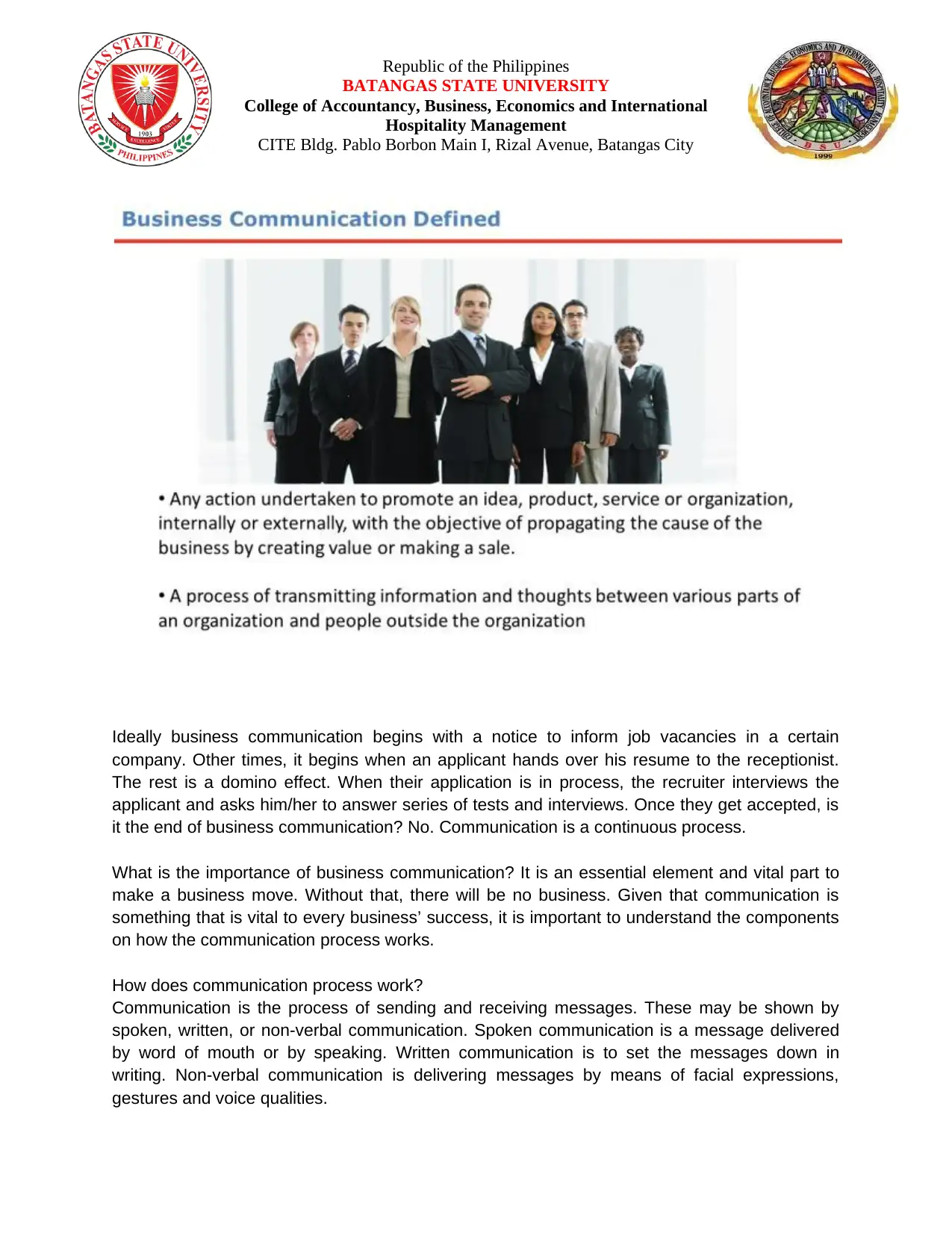
Republic of the Philippines
BATANGAS STATE UNIVERSITY
College of Accountancy, Business, Economics and International
Hospitality Management
CITE Bldg. Pablo Borbon Main I, Rizal Avenue, Batangas City
Ideally business communication begins with a notice to inform job vacancies in a certain
company. Other times, it begins when an applicant hands over his resume to the receptionist.
The rest is a domino effect. When their application is in process, the recruiter interviews the
applicant and asks him/her to answer series of tests and interviews. Once they get accepted, is
it the end of business communication? No. Communication is a continuous process.
What is the importance of business communication? It is an essential element and vital part to
make a business move. Without that, there will be no business. Given that communication is
something that is vital to every business’ success, it is important to understand the components
on how the communication process works.
How does communication process work?
Communication is the process of sending and receiving messages. These may be shown by
spoken, written, or non-verbal communication. Spoken communication is a message delivered
by word of mouth or by speaking. Written communication is to set the messages down in
writing. Non-verbal communication is delivering messages by means of facial expressions,
gestures and voice qualities.
BATANGAS STATE UNIVERSITY
College of Accountancy, Business, Economics and International
Hospitality Management
CITE Bldg. Pablo Borbon Main I, Rizal Avenue, Batangas City
Ideally business communication begins with a notice to inform job vacancies in a certain
company. Other times, it begins when an applicant hands over his resume to the receptionist.
The rest is a domino effect. When their application is in process, the recruiter interviews the
applicant and asks him/her to answer series of tests and interviews. Once they get accepted, is
it the end of business communication? No. Communication is a continuous process.
What is the importance of business communication? It is an essential element and vital part to
make a business move. Without that, there will be no business. Given that communication is
something that is vital to every business’ success, it is important to understand the components
on how the communication process works.
How does communication process work?
Communication is the process of sending and receiving messages. These may be shown by
spoken, written, or non-verbal communication. Spoken communication is a message delivered
by word of mouth or by speaking. Written communication is to set the messages down in
writing. Non-verbal communication is delivering messages by means of facial expressions,
gestures and voice qualities.
⊘ This is a preview!⊘
Do you want full access?
Subscribe today to unlock all pages.

Trusted by 1+ million students worldwide
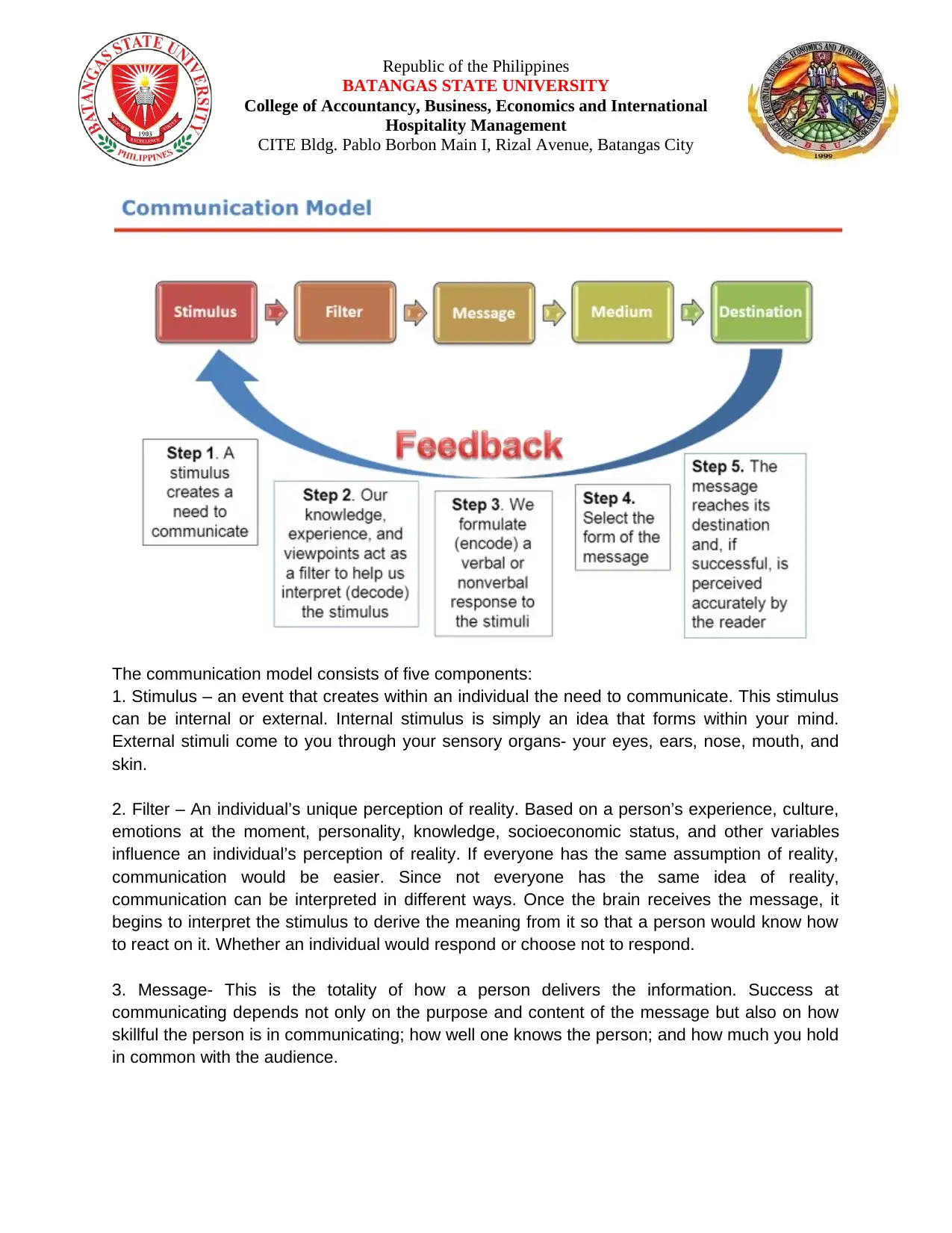
Republic of the Philippines
BATANGAS STATE UNIVERSITY
College of Accountancy, Business, Economics and International
Hospitality Management
CITE Bldg. Pablo Borbon Main I, Rizal Avenue, Batangas City
The communication model consists of five components:
1. Stimulus – an event that creates within an individual the need to communicate. This stimulus
can be internal or external. Internal stimulus is simply an idea that forms within your mind.
External stimuli come to you through your sensory organs- your eyes, ears, nose, mouth, and
skin.
2. Filter – An individual’s unique perception of reality. Based on a person’s experience, culture,
emotions at the moment, personality, knowledge, socioeconomic status, and other variables
influence an individual’s perception of reality. If everyone has the same assumption of reality,
communication would be easier. Since not everyone has the same idea of reality,
communication can be interpreted in different ways. Once the brain receives the message, it
begins to interpret the stimulus to derive the meaning from it so that a person would know how
to react on it. Whether an individual would respond or choose not to respond.
3. Message- This is the totality of how a person delivers the information. Success at
communicating depends not only on the purpose and content of the message but also on how
skillful the person is in communicating; how well one knows the person; and how much you hold
in common with the audience.
BATANGAS STATE UNIVERSITY
College of Accountancy, Business, Economics and International
Hospitality Management
CITE Bldg. Pablo Borbon Main I, Rizal Avenue, Batangas City
The communication model consists of five components:
1. Stimulus – an event that creates within an individual the need to communicate. This stimulus
can be internal or external. Internal stimulus is simply an idea that forms within your mind.
External stimuli come to you through your sensory organs- your eyes, ears, nose, mouth, and
skin.
2. Filter – An individual’s unique perception of reality. Based on a person’s experience, culture,
emotions at the moment, personality, knowledge, socioeconomic status, and other variables
influence an individual’s perception of reality. If everyone has the same assumption of reality,
communication would be easier. Since not everyone has the same idea of reality,
communication can be interpreted in different ways. Once the brain receives the message, it
begins to interpret the stimulus to derive the meaning from it so that a person would know how
to react on it. Whether an individual would respond or choose not to respond.
3. Message- This is the totality of how a person delivers the information. Success at
communicating depends not only on the purpose and content of the message but also on how
skillful the person is in communicating; how well one knows the person; and how much you hold
in common with the audience.
Paraphrase This Document
Need a fresh take? Get an instant paraphrase of this document with our AI Paraphraser
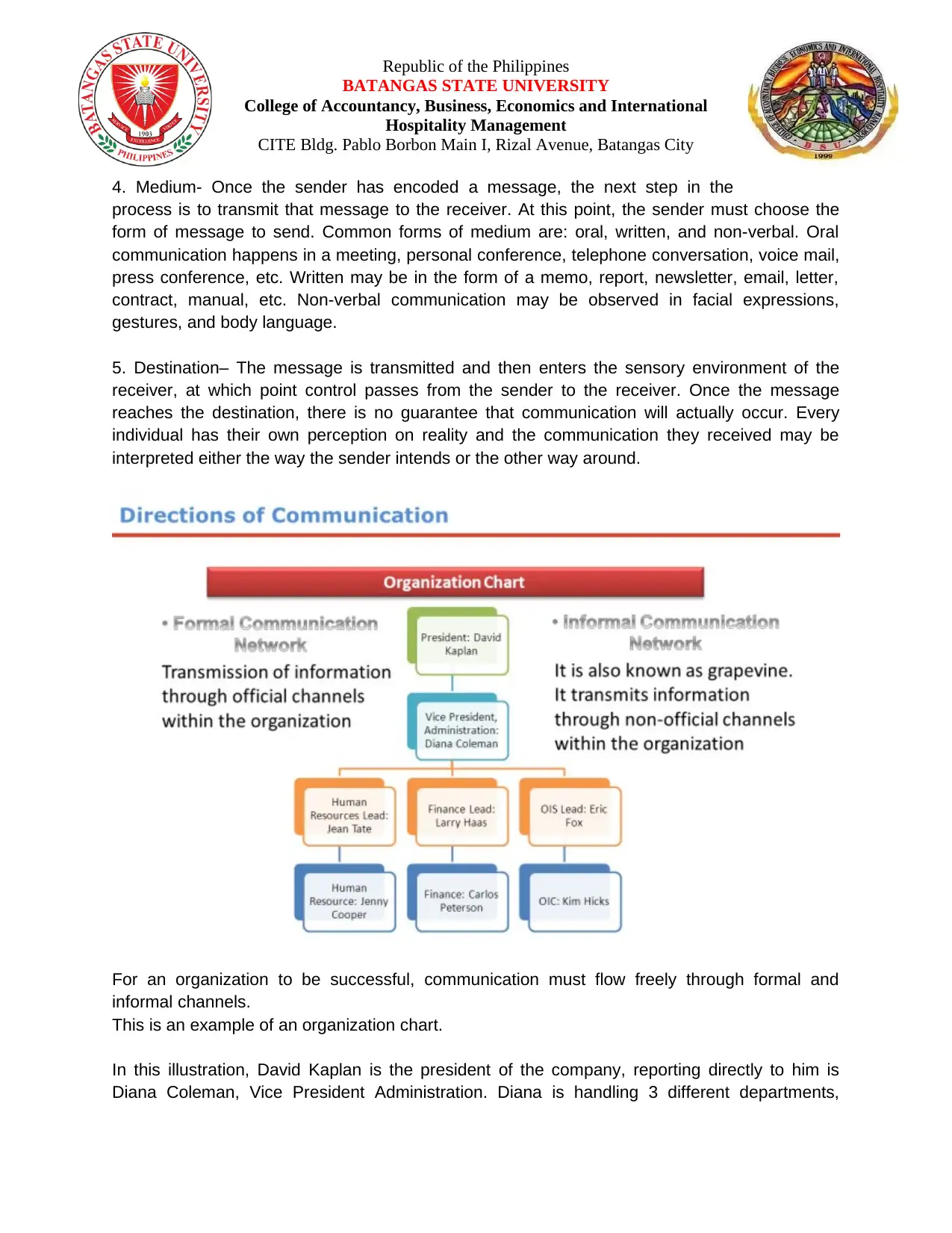
Republic of the Philippines
BATANGAS STATE UNIVERSITY
College of Accountancy, Business, Economics and International
Hospitality Management
CITE Bldg. Pablo Borbon Main I, Rizal Avenue, Batangas City
4. Medium- Once the sender has encoded a message, the next step in the
process is to transmit that message to the receiver. At this point, the sender must choose the
form of message to send. Common forms of medium are: oral, written, and non-verbal. Oral
communication happens in a meeting, personal conference, telephone conversation, voice mail,
press conference, etc. Written may be in the form of a memo, report, newsletter, email, letter,
contract, manual, etc. Non-verbal communication may be observed in facial expressions,
gestures, and body language.
5. Destination– The message is transmitted and then enters the sensory environment of the
receiver, at which point control passes from the sender to the receiver. Once the message
reaches the destination, there is no guarantee that communication will actually occur. Every
individual has their own perception on reality and the communication they received may be
interpreted either the way the sender intends or the other way around.
For an organization to be successful, communication must flow freely through formal and
informal channels.
This is an example of an organization chart.
In this illustration, David Kaplan is the president of the company, reporting directly to him is
Diana Coleman, Vice President Administration. Diana is handling 3 different departments,
BATANGAS STATE UNIVERSITY
College of Accountancy, Business, Economics and International
Hospitality Management
CITE Bldg. Pablo Borbon Main I, Rizal Avenue, Batangas City
4. Medium- Once the sender has encoded a message, the next step in the
process is to transmit that message to the receiver. At this point, the sender must choose the
form of message to send. Common forms of medium are: oral, written, and non-verbal. Oral
communication happens in a meeting, personal conference, telephone conversation, voice mail,
press conference, etc. Written may be in the form of a memo, report, newsletter, email, letter,
contract, manual, etc. Non-verbal communication may be observed in facial expressions,
gestures, and body language.
5. Destination– The message is transmitted and then enters the sensory environment of the
receiver, at which point control passes from the sender to the receiver. Once the message
reaches the destination, there is no guarantee that communication will actually occur. Every
individual has their own perception on reality and the communication they received may be
interpreted either the way the sender intends or the other way around.
For an organization to be successful, communication must flow freely through formal and
informal channels.
This is an example of an organization chart.
In this illustration, David Kaplan is the president of the company, reporting directly to him is
Diana Coleman, Vice President Administration. Diana is handling 3 different departments,
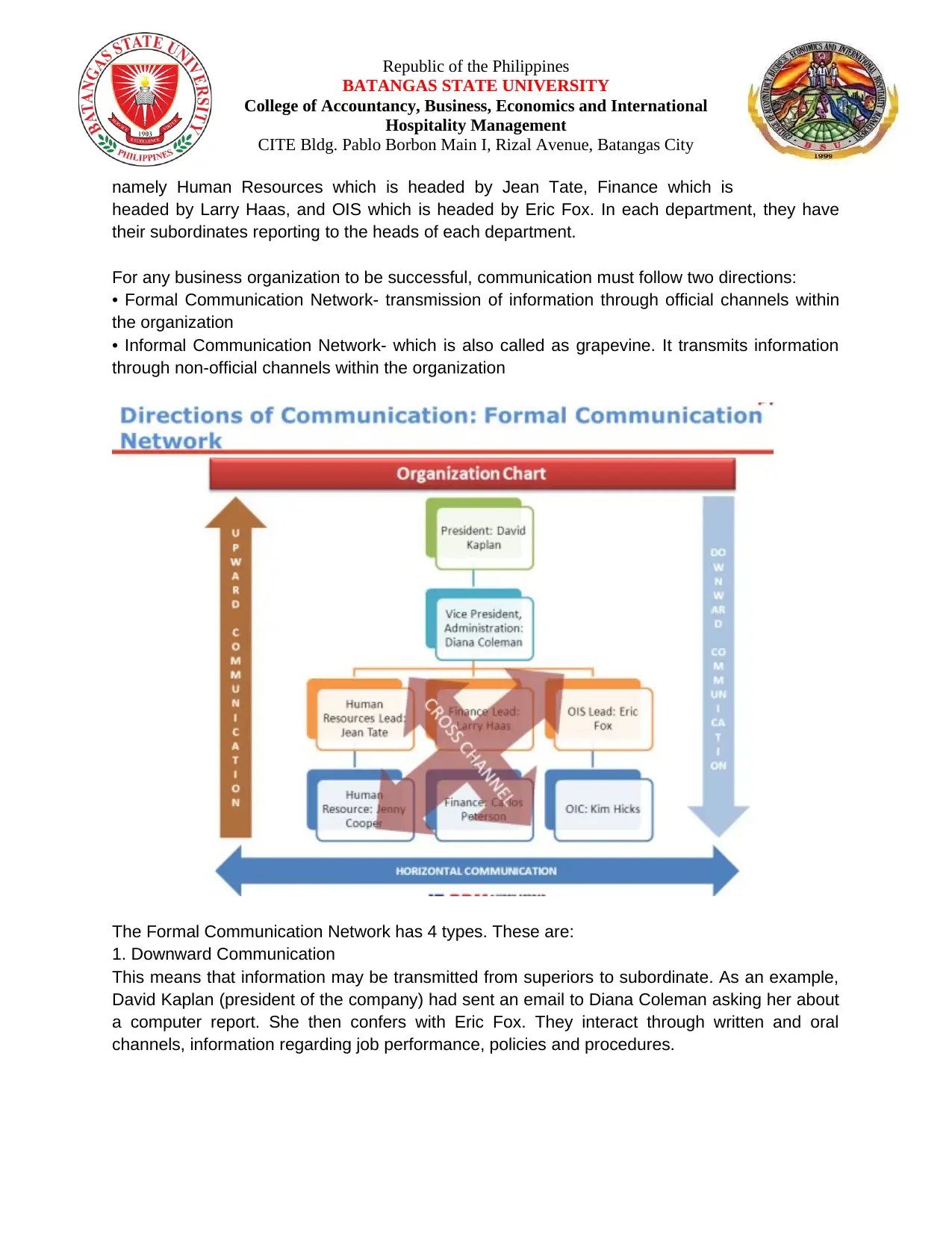
Republic of the Philippines
BATANGAS STATE UNIVERSITY
College of Accountancy, Business, Economics and International
Hospitality Management
CITE Bldg. Pablo Borbon Main I, Rizal Avenue, Batangas City
namely Human Resources which is headed by Jean Tate, Finance which is
headed by Larry Haas, and OIS which is headed by Eric Fox. In each department, they have
their subordinates reporting to the heads of each department.
For any business organization to be successful, communication must follow two directions:
• Formal Communication Network- transmission of information through official channels within
the organization
• Informal Communication Network- which is also called as grapevine. It transmits information
through non-official channels within the organization
The Formal Communication Network has 4 types. These are:
1. Downward Communication
This means that information may be transmitted from superiors to subordinate. As an example,
David Kaplan (president of the company) had sent an email to Diana Coleman asking her about
a computer report. She then confers with Eric Fox. They interact through written and oral
channels, information regarding job performance, policies and procedures.
BATANGAS STATE UNIVERSITY
College of Accountancy, Business, Economics and International
Hospitality Management
CITE Bldg. Pablo Borbon Main I, Rizal Avenue, Batangas City
namely Human Resources which is headed by Jean Tate, Finance which is
headed by Larry Haas, and OIS which is headed by Eric Fox. In each department, they have
their subordinates reporting to the heads of each department.
For any business organization to be successful, communication must follow two directions:
• Formal Communication Network- transmission of information through official channels within
the organization
• Informal Communication Network- which is also called as grapevine. It transmits information
through non-official channels within the organization
The Formal Communication Network has 4 types. These are:
1. Downward Communication
This means that information may be transmitted from superiors to subordinate. As an example,
David Kaplan (president of the company) had sent an email to Diana Coleman asking her about
a computer report. She then confers with Eric Fox. They interact through written and oral
channels, information regarding job performance, policies and procedures.
⊘ This is a preview!⊘
Do you want full access?
Subscribe today to unlock all pages.

Trusted by 1+ million students worldwide
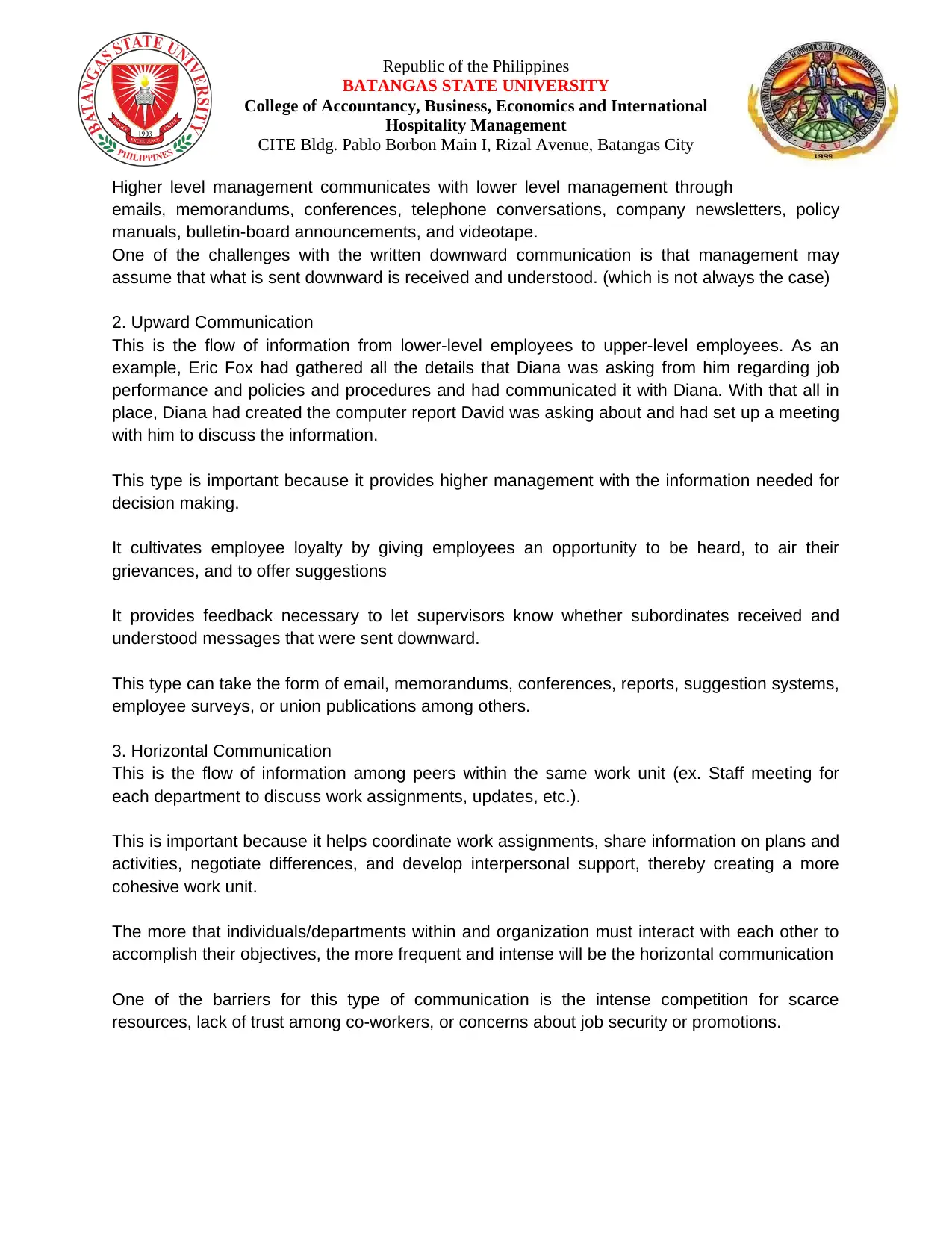
Republic of the Philippines
BATANGAS STATE UNIVERSITY
College of Accountancy, Business, Economics and International
Hospitality Management
CITE Bldg. Pablo Borbon Main I, Rizal Avenue, Batangas City
Higher level management communicates with lower level management through
emails, memorandums, conferences, telephone conversations, company newsletters, policy
manuals, bulletin-board announcements, and videotape.
One of the challenges with the written downward communication is that management may
assume that what is sent downward is received and understood. (which is not always the case)
2. Upward Communication
This is the flow of information from lower-level employees to upper-level employees. As an
example, Eric Fox had gathered all the details that Diana was asking from him regarding job
performance and policies and procedures and had communicated it with Diana. With that all in
place, Diana had created the computer report David was asking about and had set up a meeting
with him to discuss the information.
This type is important because it provides higher management with the information needed for
decision making.
It cultivates employee loyalty by giving employees an opportunity to be heard, to air their
grievances, and to offer suggestions
It provides feedback necessary to let supervisors know whether subordinates received and
understood messages that were sent downward.
This type can take the form of email, memorandums, conferences, reports, suggestion systems,
employee surveys, or union publications among others.
3. Horizontal Communication
This is the flow of information among peers within the same work unit (ex. Staff meeting for
each department to discuss work assignments, updates, etc.).
This is important because it helps coordinate work assignments, share information on plans and
activities, negotiate differences, and develop interpersonal support, thereby creating a more
cohesive work unit.
The more that individuals/departments within and organization must interact with each other to
accomplish their objectives, the more frequent and intense will be the horizontal communication
One of the barriers for this type of communication is the intense competition for scarce
resources, lack of trust among co-workers, or concerns about job security or promotions.
BATANGAS STATE UNIVERSITY
College of Accountancy, Business, Economics and International
Hospitality Management
CITE Bldg. Pablo Borbon Main I, Rizal Avenue, Batangas City
Higher level management communicates with lower level management through
emails, memorandums, conferences, telephone conversations, company newsletters, policy
manuals, bulletin-board announcements, and videotape.
One of the challenges with the written downward communication is that management may
assume that what is sent downward is received and understood. (which is not always the case)
2. Upward Communication
This is the flow of information from lower-level employees to upper-level employees. As an
example, Eric Fox had gathered all the details that Diana was asking from him regarding job
performance and policies and procedures and had communicated it with Diana. With that all in
place, Diana had created the computer report David was asking about and had set up a meeting
with him to discuss the information.
This type is important because it provides higher management with the information needed for
decision making.
It cultivates employee loyalty by giving employees an opportunity to be heard, to air their
grievances, and to offer suggestions
It provides feedback necessary to let supervisors know whether subordinates received and
understood messages that were sent downward.
This type can take the form of email, memorandums, conferences, reports, suggestion systems,
employee surveys, or union publications among others.
3. Horizontal Communication
This is the flow of information among peers within the same work unit (ex. Staff meeting for
each department to discuss work assignments, updates, etc.).
This is important because it helps coordinate work assignments, share information on plans and
activities, negotiate differences, and develop interpersonal support, thereby creating a more
cohesive work unit.
The more that individuals/departments within and organization must interact with each other to
accomplish their objectives, the more frequent and intense will be the horizontal communication
One of the barriers for this type of communication is the intense competition for scarce
resources, lack of trust among co-workers, or concerns about job security or promotions.
Paraphrase This Document
Need a fresh take? Get an instant paraphrase of this document with our AI Paraphraser
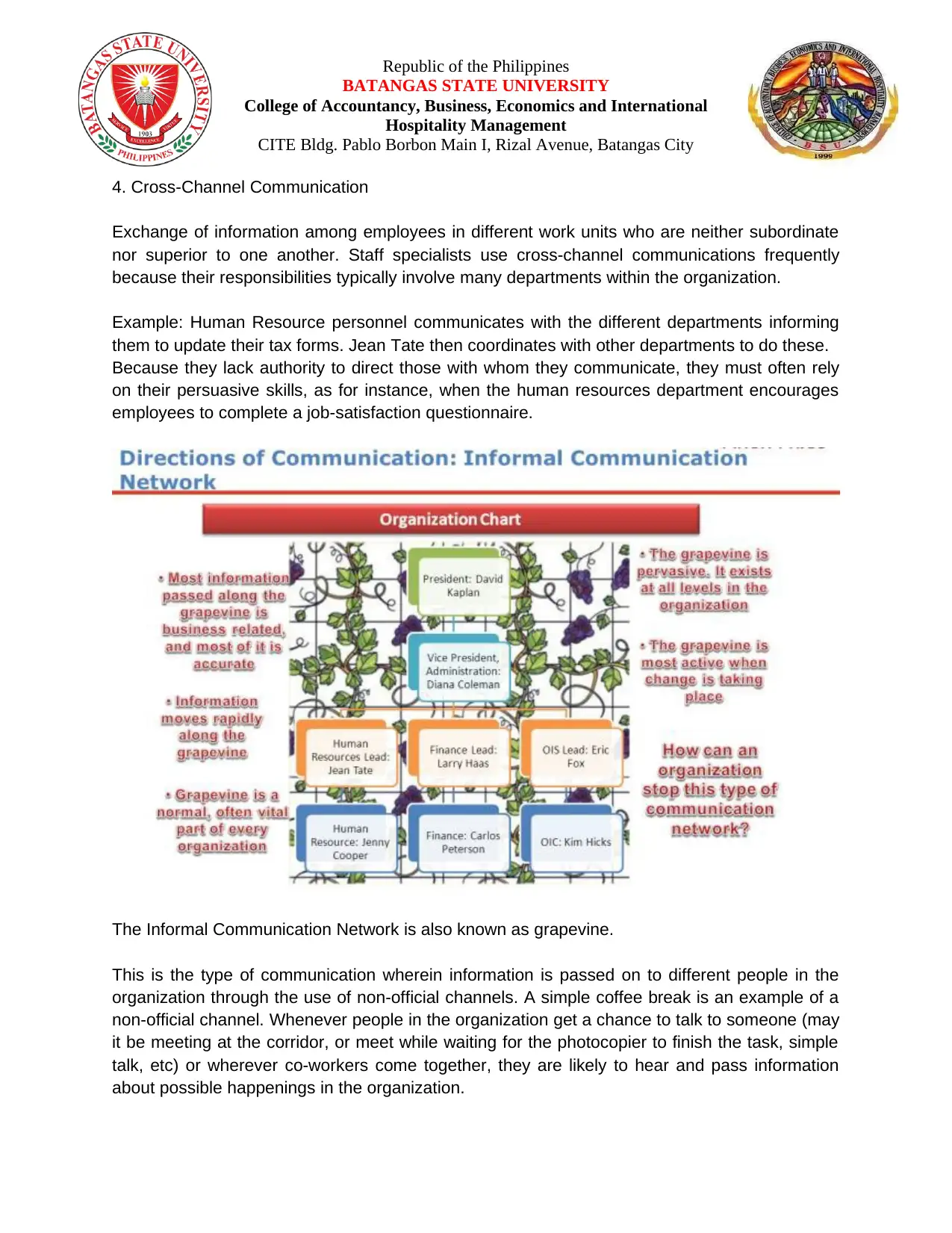
Republic of the Philippines
BATANGAS STATE UNIVERSITY
College of Accountancy, Business, Economics and International
Hospitality Management
CITE Bldg. Pablo Borbon Main I, Rizal Avenue, Batangas City
4. Cross-Channel Communication
Exchange of information among employees in different work units who are neither subordinate
nor superior to one another. Staff specialists use cross-channel communications frequently
because their responsibilities typically involve many departments within the organization.
Example: Human Resource personnel communicates with the different departments informing
them to update their tax forms. Jean Tate then coordinates with other departments to do these.
Because they lack authority to direct those with whom they communicate, they must often rely
on their persuasive skills, as for instance, when the human resources department encourages
employees to complete a job-satisfaction questionnaire.
The Informal Communication Network is also known as grapevine.
This is the type of communication wherein information is passed on to different people in the
organization through the use of non-official channels. A simple coffee break is an example of a
non-official channel. Whenever people in the organization get a chance to talk to someone (may
it be meeting at the corridor, or meet while waiting for the photocopier to finish the task, simple
talk, etc) or wherever co-workers come together, they are likely to hear and pass information
about possible happenings in the organization.
BATANGAS STATE UNIVERSITY
College of Accountancy, Business, Economics and International
Hospitality Management
CITE Bldg. Pablo Borbon Main I, Rizal Avenue, Batangas City
4. Cross-Channel Communication
Exchange of information among employees in different work units who are neither subordinate
nor superior to one another. Staff specialists use cross-channel communications frequently
because their responsibilities typically involve many departments within the organization.
Example: Human Resource personnel communicates with the different departments informing
them to update their tax forms. Jean Tate then coordinates with other departments to do these.
Because they lack authority to direct those with whom they communicate, they must often rely
on their persuasive skills, as for instance, when the human resources department encourages
employees to complete a job-satisfaction questionnaire.
The Informal Communication Network is also known as grapevine.
This is the type of communication wherein information is passed on to different people in the
organization through the use of non-official channels. A simple coffee break is an example of a
non-official channel. Whenever people in the organization get a chance to talk to someone (may
it be meeting at the corridor, or meet while waiting for the photocopier to finish the task, simple
talk, etc) or wherever co-workers come together, they are likely to hear and pass information
about possible happenings in the organization.
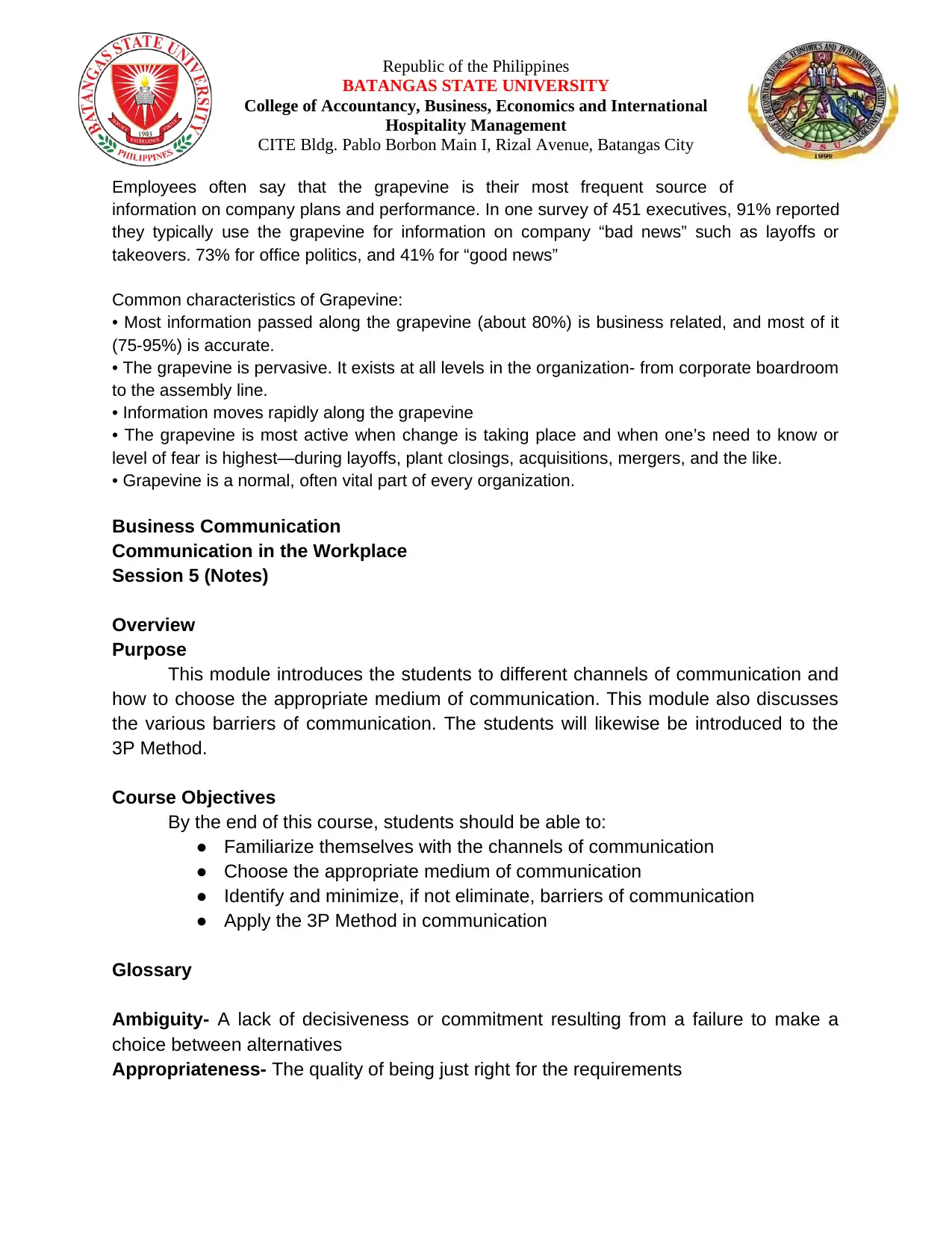
Republic of the Philippines
BATANGAS STATE UNIVERSITY
College of Accountancy, Business, Economics and International
Hospitality Management
CITE Bldg. Pablo Borbon Main I, Rizal Avenue, Batangas City
Employees often say that the grapevine is their most frequent source of
information on company plans and performance. In one survey of 451 executives, 91% reported
they typically use the grapevine for information on company “bad news” such as layoffs or
takeovers. 73% for office politics, and 41% for “good news”
Common characteristics of Grapevine:
• Most information passed along the grapevine (about 80%) is business related, and most of it
(75-95%) is accurate.
• The grapevine is pervasive. It exists at all levels in the organization- from corporate boardroom
to the assembly line.
• Information moves rapidly along the grapevine
• The grapevine is most active when change is taking place and when one’s need to know or
level of fear is highest—during layoffs, plant closings, acquisitions, mergers, and the like.
• Grapevine is a normal, often vital part of every organization.
Business Communication
Communication in the Workplace
Session 5 (Notes)
Overview
Purpose
This module introduces the students to different channels of communication and
how to choose the appropriate medium of communication. This module also discusses
the various barriers of communication. The students will likewise be introduced to the
3P Method.
Course Objectives
By the end of this course, students should be able to:
● Familiarize themselves with the channels of communication
● Choose the appropriate medium of communication
● Identify and minimize, if not eliminate, barriers of communication
● Apply the 3P Method in communication
Glossary
Ambiguity- A lack of decisiveness or commitment resulting from a failure to make a
choice between alternatives
Appropriateness- The quality of being just right for the requirements
BATANGAS STATE UNIVERSITY
College of Accountancy, Business, Economics and International
Hospitality Management
CITE Bldg. Pablo Borbon Main I, Rizal Avenue, Batangas City
Employees often say that the grapevine is their most frequent source of
information on company plans and performance. In one survey of 451 executives, 91% reported
they typically use the grapevine for information on company “bad news” such as layoffs or
takeovers. 73% for office politics, and 41% for “good news”
Common characteristics of Grapevine:
• Most information passed along the grapevine (about 80%) is business related, and most of it
(75-95%) is accurate.
• The grapevine is pervasive. It exists at all levels in the organization- from corporate boardroom
to the assembly line.
• Information moves rapidly along the grapevine
• The grapevine is most active when change is taking place and when one’s need to know or
level of fear is highest—during layoffs, plant closings, acquisitions, mergers, and the like.
• Grapevine is a normal, often vital part of every organization.
Business Communication
Communication in the Workplace
Session 5 (Notes)
Overview
Purpose
This module introduces the students to different channels of communication and
how to choose the appropriate medium of communication. This module also discusses
the various barriers of communication. The students will likewise be introduced to the
3P Method.
Course Objectives
By the end of this course, students should be able to:
● Familiarize themselves with the channels of communication
● Choose the appropriate medium of communication
● Identify and minimize, if not eliminate, barriers of communication
● Apply the 3P Method in communication
Glossary
Ambiguity- A lack of decisiveness or commitment resulting from a failure to make a
choice between alternatives
Appropriateness- The quality of being just right for the requirements
⊘ This is a preview!⊘
Do you want full access?
Subscribe today to unlock all pages.

Trusted by 1+ million students worldwide
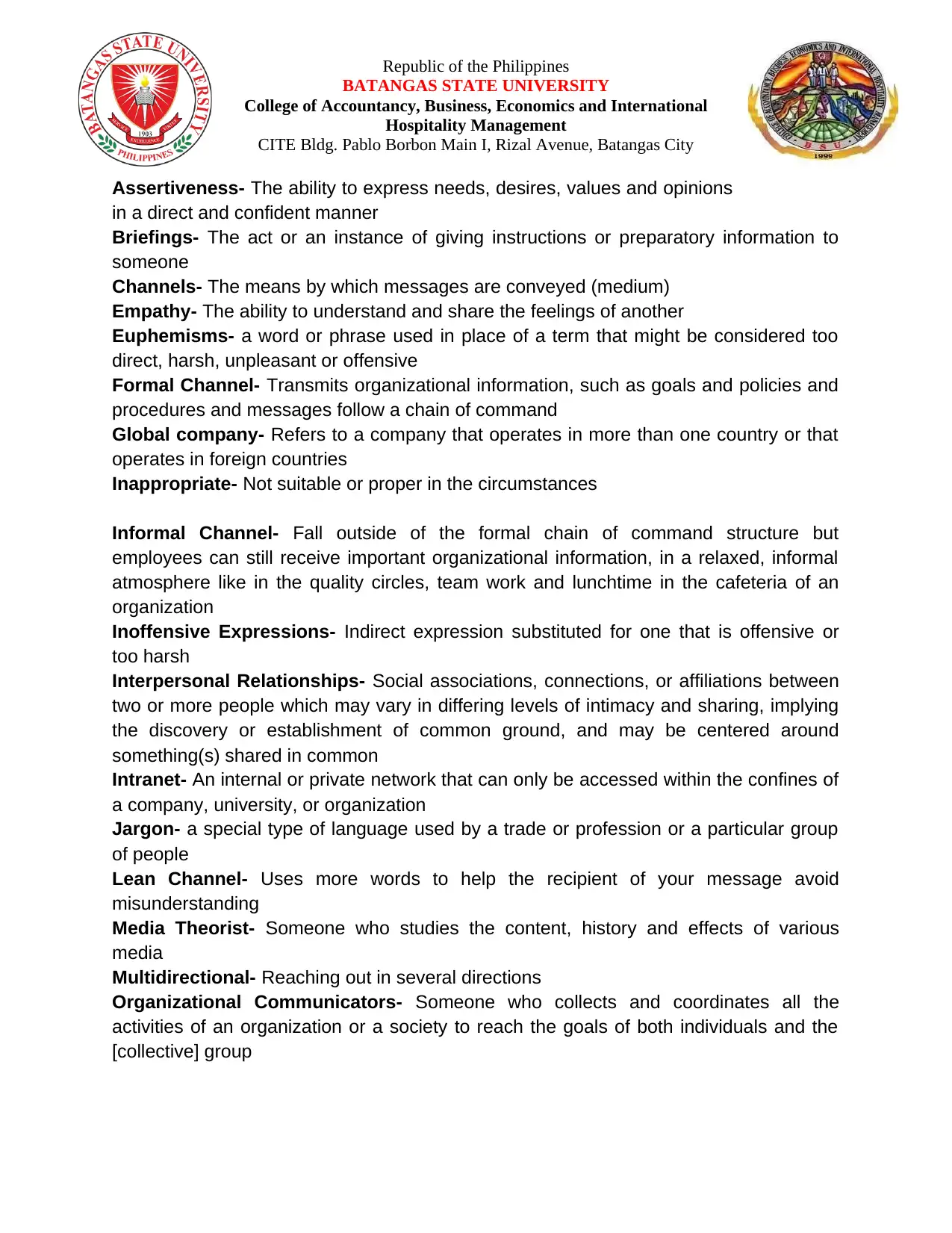
Republic of the Philippines
BATANGAS STATE UNIVERSITY
College of Accountancy, Business, Economics and International
Hospitality Management
CITE Bldg. Pablo Borbon Main I, Rizal Avenue, Batangas City
Assertiveness- The ability to express needs, desires, values and opinions
in a direct and confident manner
Briefings- The act or an instance of giving instructions or preparatory information to
someone
Channels- The means by which messages are conveyed (medium)
Empathy- The ability to understand and share the feelings of another
Euphemisms- a word or phrase used in place of a term that might be considered too
direct, harsh, unpleasant or offensive
Formal Channel- Transmits organizational information, such as goals and policies and
procedures and messages follow a chain of command
Global company- Refers to a company that operates in more than one country or that
operates in foreign countries
Inappropriate- Not suitable or proper in the circumstances
Informal Channel- Fall outside of the formal chain of command structure but
employees can still receive important organizational information, in a relaxed, informal
atmosphere like in the quality circles, team work and lunchtime in the cafeteria of an
organization
Inoffensive Expressions- Indirect expression substituted for one that is offensive or
too harsh
Interpersonal Relationships- Social associations, connections, or affiliations between
two or more people which may vary in differing levels of intimacy and sharing, implying
the discovery or establishment of common ground, and may be centered around
something(s) shared in common
Intranet- An internal or private network that can only be accessed within the confines of
a company, university, or organization
Jargon- a special type of language used by a trade or profession or a particular group
of people
Lean Channel- Uses more words to help the recipient of your message avoid
misunderstanding
Media Theorist- Someone who studies the content, history and effects of various
media
Multidirectional- Reaching out in several directions
Organizational Communicators- Someone who collects and coordinates all the
activities of an organization or a society to reach the goals of both individuals and the
[collective] group
BATANGAS STATE UNIVERSITY
College of Accountancy, Business, Economics and International
Hospitality Management
CITE Bldg. Pablo Borbon Main I, Rizal Avenue, Batangas City
Assertiveness- The ability to express needs, desires, values and opinions
in a direct and confident manner
Briefings- The act or an instance of giving instructions or preparatory information to
someone
Channels- The means by which messages are conveyed (medium)
Empathy- The ability to understand and share the feelings of another
Euphemisms- a word or phrase used in place of a term that might be considered too
direct, harsh, unpleasant or offensive
Formal Channel- Transmits organizational information, such as goals and policies and
procedures and messages follow a chain of command
Global company- Refers to a company that operates in more than one country or that
operates in foreign countries
Inappropriate- Not suitable or proper in the circumstances
Informal Channel- Fall outside of the formal chain of command structure but
employees can still receive important organizational information, in a relaxed, informal
atmosphere like in the quality circles, team work and lunchtime in the cafeteria of an
organization
Inoffensive Expressions- Indirect expression substituted for one that is offensive or
too harsh
Interpersonal Relationships- Social associations, connections, or affiliations between
two or more people which may vary in differing levels of intimacy and sharing, implying
the discovery or establishment of common ground, and may be centered around
something(s) shared in common
Intranet- An internal or private network that can only be accessed within the confines of
a company, university, or organization
Jargon- a special type of language used by a trade or profession or a particular group
of people
Lean Channel- Uses more words to help the recipient of your message avoid
misunderstanding
Media Theorist- Someone who studies the content, history and effects of various
media
Multidirectional- Reaching out in several directions
Organizational Communicators- Someone who collects and coordinates all the
activities of an organization or a society to reach the goals of both individuals and the
[collective] group
Paraphrase This Document
Need a fresh take? Get an instant paraphrase of this document with our AI Paraphraser
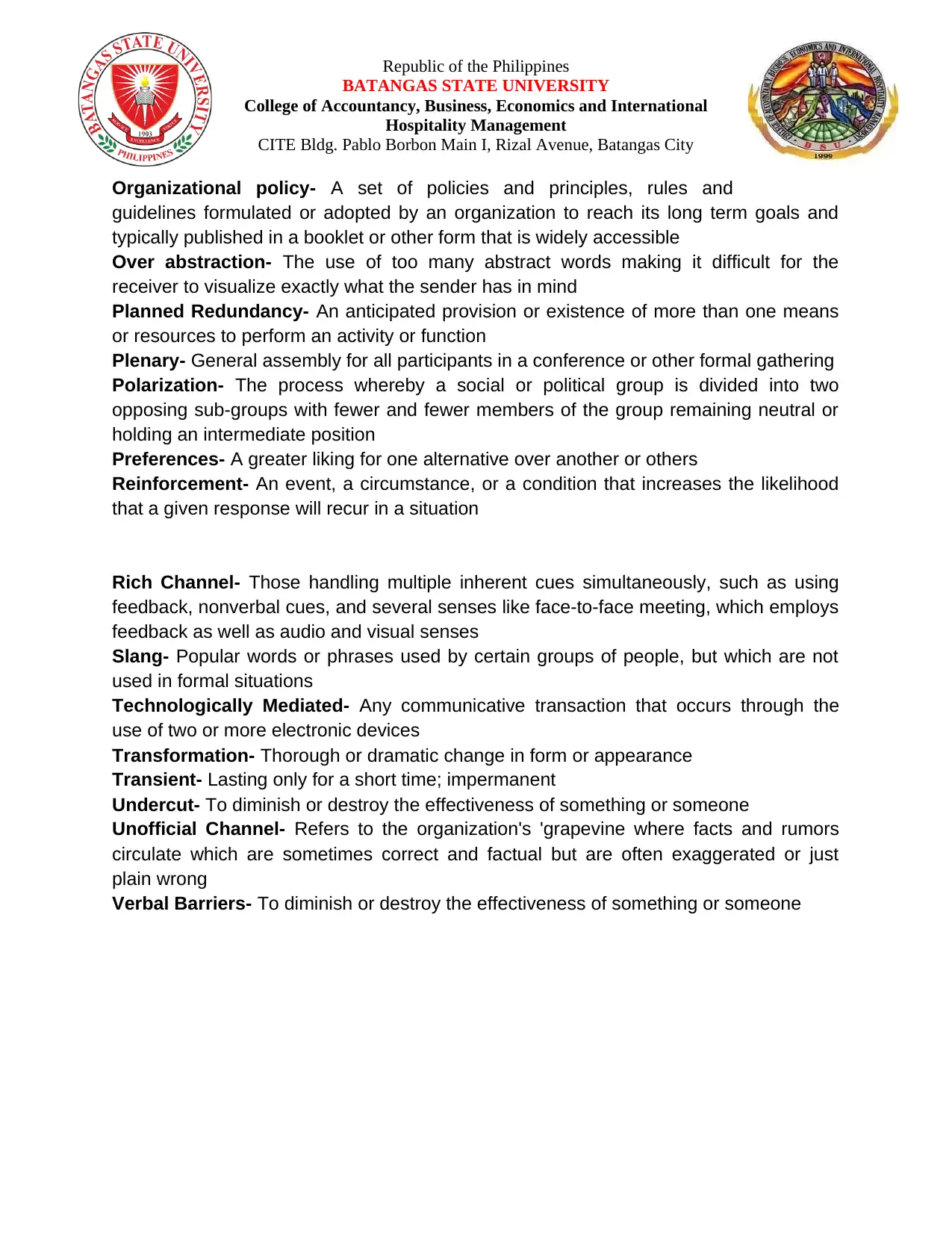
Republic of the Philippines
BATANGAS STATE UNIVERSITY
College of Accountancy, Business, Economics and International
Hospitality Management
CITE Bldg. Pablo Borbon Main I, Rizal Avenue, Batangas City
Organizational policy- A set of policies and principles, rules and
guidelines formulated or adopted by an organization to reach its long term goals and
typically published in a booklet or other form that is widely accessible
Over abstraction- The use of too many abstract words making it difficult for the
receiver to visualize exactly what the sender has in mind
Planned Redundancy- An anticipated provision or existence of more than one means
or resources to perform an activity or function
Plenary- General assembly for all participants in a conference or other formal gathering
Polarization- The process whereby a social or political group is divided into two
opposing sub-groups with fewer and fewer members of the group remaining neutral or
holding an intermediate position
Preferences- A greater liking for one alternative over another or others
Reinforcement- An event, a circumstance, or a condition that increases the likelihood
that a given response will recur in a situation
Rich Channel- Those handling multiple inherent cues simultaneously, such as using
feedback, nonverbal cues, and several senses like face-to-face meeting, which employs
feedback as well as audio and visual senses
Slang- Popular words or phrases used by certain groups of people, but which are not
used in formal situations
Technologically Mediated- Any communicative transaction that occurs through the
use of two or more electronic devices
Transformation- Thorough or dramatic change in form or appearance
Transient- Lasting only for a short time; impermanent
Undercut- To diminish or destroy the effectiveness of something or someone
Unofficial Channel- Refers to the organization's 'grapevine where facts and rumors
circulate which are sometimes correct and factual but are often exaggerated or just
plain wrong
Verbal Barriers- To diminish or destroy the effectiveness of something or someone
BATANGAS STATE UNIVERSITY
College of Accountancy, Business, Economics and International
Hospitality Management
CITE Bldg. Pablo Borbon Main I, Rizal Avenue, Batangas City
Organizational policy- A set of policies and principles, rules and
guidelines formulated or adopted by an organization to reach its long term goals and
typically published in a booklet or other form that is widely accessible
Over abstraction- The use of too many abstract words making it difficult for the
receiver to visualize exactly what the sender has in mind
Planned Redundancy- An anticipated provision or existence of more than one means
or resources to perform an activity or function
Plenary- General assembly for all participants in a conference or other formal gathering
Polarization- The process whereby a social or political group is divided into two
opposing sub-groups with fewer and fewer members of the group remaining neutral or
holding an intermediate position
Preferences- A greater liking for one alternative over another or others
Reinforcement- An event, a circumstance, or a condition that increases the likelihood
that a given response will recur in a situation
Rich Channel- Those handling multiple inherent cues simultaneously, such as using
feedback, nonverbal cues, and several senses like face-to-face meeting, which employs
feedback as well as audio and visual senses
Slang- Popular words or phrases used by certain groups of people, but which are not
used in formal situations
Technologically Mediated- Any communicative transaction that occurs through the
use of two or more electronic devices
Transformation- Thorough or dramatic change in form or appearance
Transient- Lasting only for a short time; impermanent
Undercut- To diminish or destroy the effectiveness of something or someone
Unofficial Channel- Refers to the organization's 'grapevine where facts and rumors
circulate which are sometimes correct and factual but are often exaggerated or just
plain wrong
Verbal Barriers- To diminish or destroy the effectiveness of something or someone
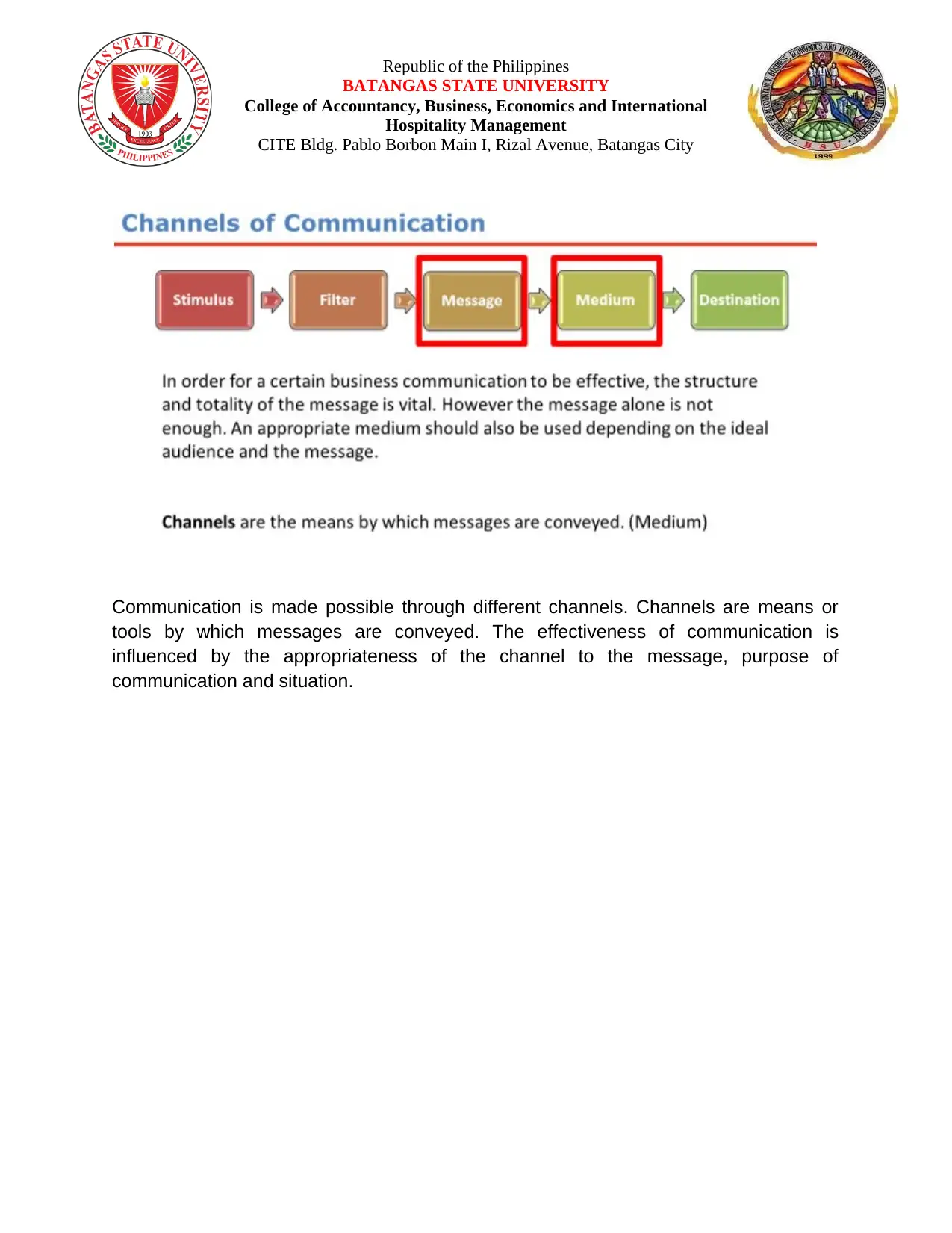
Republic of the Philippines
BATANGAS STATE UNIVERSITY
College of Accountancy, Business, Economics and International
Hospitality Management
CITE Bldg. Pablo Borbon Main I, Rizal Avenue, Batangas City
Communication is made possible through different channels. Channels are means or
tools by which messages are conveyed. The effectiveness of communication is
influenced by the appropriateness of the channel to the message, purpose of
communication and situation.
BATANGAS STATE UNIVERSITY
College of Accountancy, Business, Economics and International
Hospitality Management
CITE Bldg. Pablo Borbon Main I, Rizal Avenue, Batangas City
Communication is made possible through different channels. Channels are means or
tools by which messages are conveyed. The effectiveness of communication is
influenced by the appropriateness of the channel to the message, purpose of
communication and situation.
⊘ This is a preview!⊘
Do you want full access?
Subscribe today to unlock all pages.

Trusted by 1+ million students worldwide
1 out of 43
Related Documents
Your All-in-One AI-Powered Toolkit for Academic Success.
+13062052269
info@desklib.com
Available 24*7 on WhatsApp / Email
![[object Object]](/_next/static/media/star-bottom.7253800d.svg)
Unlock your academic potential
Copyright © 2020–2025 A2Z Services. All Rights Reserved. Developed and managed by ZUCOL.




